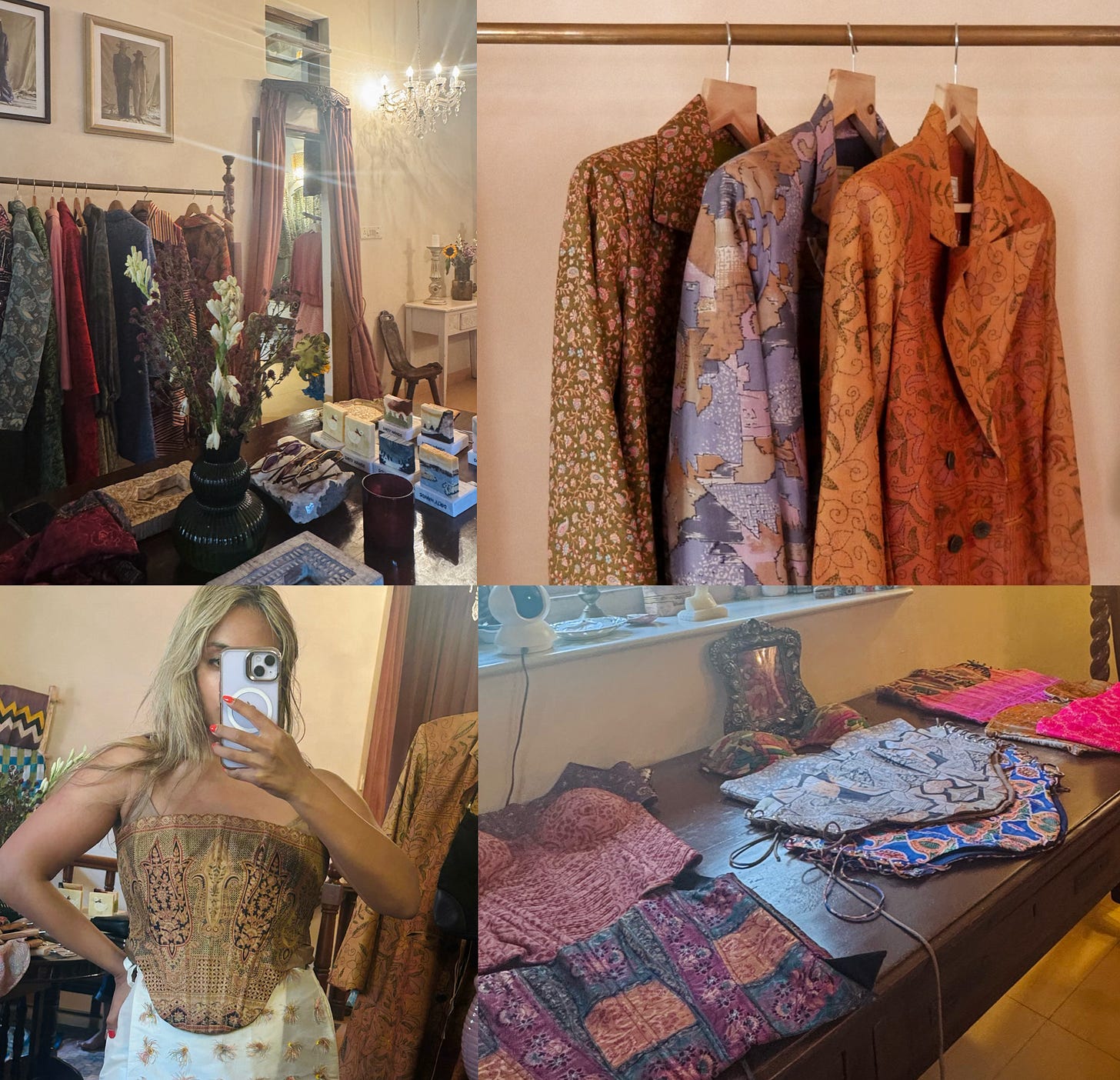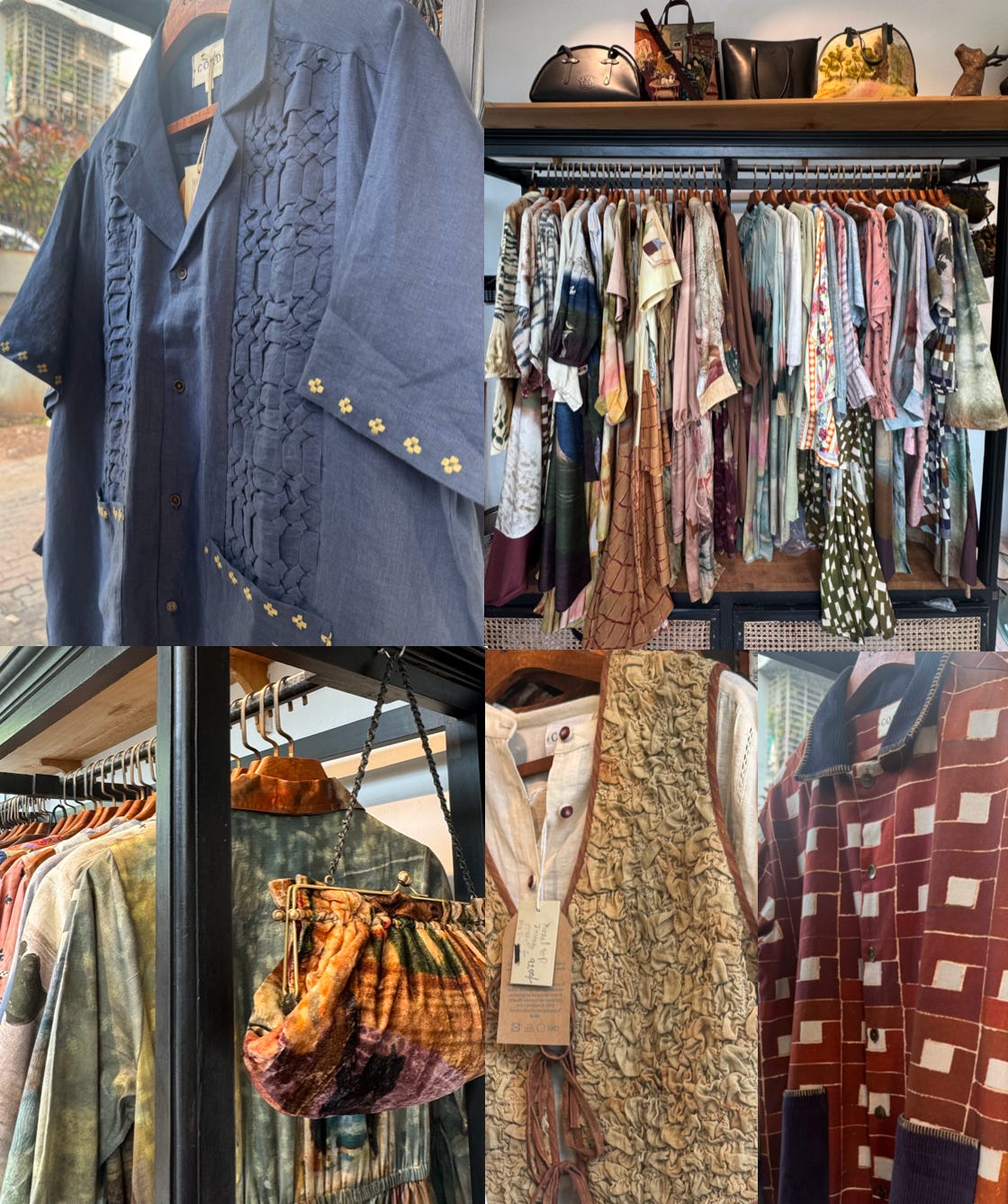Ever since Chemena Kamali’s debut Chloe collection in March 2024 confirmed my forecast of the return of bohemian aesthetics, I’ve been patiently waiting, curious to see how other designers would interpret the trend. The last time boho was in style, it became endlessly entangled with accusations of cultural appropriation. Do you remember the hipster keffiyehs, music festival headdresses, street style kimonos, and pop stars wearing bindis?
Nuance is key when it comes to differentiating symbiotic cultural exchange from offensive cultural appropriation. So I’ve been quite keen to see whether contemporary designers would explore cross-cultural inspirations, and how they’d approach doing so. I thought this season’s White Lotus, set in Thailand, was the perfect way to set the scene, and now we’re starting to see some clear examples in fashion.
The first major moment I noticed was the popular Tory Burch ‘mirror dress,’ made in India with shisha embroidery - as covered by
.Connecting the Tory Burch mirror dress, 1999 Prada & Shisha Embroidery. I researched and made this video about the Indian origins of the mirrorwork embroidery that’s having a *trend moment*, and it got picked up in The Cut!
Then came last week’s Prada Men’s SS26 show prominently featuring traditional Kolhapuri sandals.
Kolhapuri chappals, which received a Geographical Indication tag in 2019, have been made for generations across eight districts in Maharashtra and Karnataka. They’re typically constructed using sun-dried buffalo hide, and are shaped and stitched entirely by hand without synthetic materials or adhesives. Depending on the complexity, a single pair can take up to two weeks to finish. (WWD)
Miuccia and Raf expressed “a change of tone” seeking something “calming, positive, and balanced," and their show notes proposed“dismantling of meaning, and dismantling power.” Fascinatingly, there was no mention of the reference to the Indian footwear, or indeed, the idea of cross-cultural exchange at all. It strikes me as somewhat hilarious for European designers to speak of “dismantling power” without addressing their use of a previously colonized country’s traditional attire as a styling device.
The brand later made a statement, in response to viral criticism on social media, which attempts to remedy this in retrospect:
"Prada acknowledges that sandals inspired by traditional Indian footwear made in specific districts in Maharashtra and Karnataka, India, were featured in its Men's 2026 Spring Summer show in Milan. We are committed to responsible design practices, fostering cultural engagement, and opening a dialogue for a meaningful exchange with local Indian artisan communities as we have done in the past in other collections to ensure the rightful recognition of their craft. We are in contact with the Maharashtra Chamber of Commerce, Industry & Agriculture on this topic." (Economic Times)
In my opinion, neither utilizing craft techniques originating in other country, nor styling clothes with accessories you may have picked up on vacation, are inherently problematic. But there’s so much latent potential to be drawn from designers actually opening a dialogue with the cultures they’re taking inspiration from. It would have been a lot more interesting if the shisha artisans were featured prominently, with videos of their workmanship and perhaps a portion of profits dedicated towards sustaining these handicraft communities. Or, if the sandals were developed via a collaboration with Indian producers, like the Economic Times suggests: “It would be meaningful for both brands and artisans if there was transparent commercial collaboration and due credit."
In their current iteration, both Tory Burch’s mirror dress and Prada’s Kolhapuri knockoffs perpetuate the same perceptual issues we discussed last month, wherein artisanal techniques originating in the Global South are only considered worthy of a ‘luxury’ designation after being divorced from their cultural context and filtered through the lens of European or American designers.
It’s interesting to contrast these examples with, for instance, the recent Nike collaboration with Indian design collective NorBlackNorWhite, or Pharrell’s Louis Vuitton SS26 show, which unabashedly spotlighted Indian heritage and craftsmanship as the collection’s inspiration. The Vogue and WWD reviews explain how countless details were inspired by the design team’s travels, from “screen printed text designed to give the patchy impression of having been hand-painted, like the street advertising …observed in India,” to bejeweled embroidery decorating clothes and bags.
Williams said hitting up local markets and suppliers — from printmaking workshops to embroiderers — was his favorite part of the trip. “What art and painting is to Paris, textiles and embroidery is to India,” he said. “The intricacies were just off the charts.” (WWD)
Louis Vuitton also collaborated with architect Bijoy Jain, the founder of Studio Mumbai, on the design of a runway set inspired by the snakes & ladders board game with origins and ancient India; and the show’s soundtrack featured “Yaara Punjabi,” a track co-produced with legendary Indian film composer A.R. Rahma. As Williams explains, “Storytelling provides context, and when you provide context, it makes it easier for people to understand what your true intentions are.”
It’s so obvious, and yet, Miuccia & Raf entirely missed the mark.
48 HOURS IN MUMBAI
Coincidentally, I’ve just spent the past two weeks in India. For the most part, I didn’t do much other than spending six hours everyday in banks and government offices that looked like this while attempting to settle my father’s accounts. However, midway through I managed to escape for a fun weekend in Mumbai, and thought I’d share some of my discoveries, since, after all, it seems quite topical.
Definitely my favorite find, this design studio founded by Divya Saini focuses on upcycling preloved saris and vintage Indian textiles, and “reimagining them into one-of-a-kind contemporary silhouettes.” Tucked away in a residential home, the shoppable studio is a hidden gem. The corsets are incredible, I purchased the one I’m wearing in the photo, as well as a silk button down shirt. Their website offers worldwide shipping, and they mentioned an upcoming popup in Brooklyn in July, with more details to come via Instagram.
This is an interesting concept that offers options to both rent or buy, and features an assortment of both new pieces from international indie creators and secondhand gems from well-known designers. I was very tempted by those vintage pointy-toed flats pictured, but resisted, and took note of some really cool emerging brands I’d never seen before, like Margn (India), Ituvana (India), Samaaj (India), Clara Pinto (Argentina), Grita (Portugal), and Kuta House (Poland).
I had visited the Jaipur location of this multi-brand store several years ago, so was happy to learn they now have a Mumbai outpost. The range focuses on Indian craftsmanship applied to contemporary western silhouettes, featuring designers like ElevenEleven, Kissa Goi, Choyal, White Champa, and Mama India. I bought a plant-dyed slip dress by Akane Studio.
Across the street from Dhora, I spotted Cord, a tiny shop filled with color. It turns out the brand has been around for a decade, working in close partnership with local artisans to create unique pieces. The detail was enchanting, from intricate smocking textures to blockprinted cottons and handpainted velvets.
This is a holistic natural perfumery that focuses on distilling local ingredients to create fragrance oils designed to layer for a personalized scent. The brand collaborates with producers in northern regions of the country to ensure ethical and sustainable processes from sourcing to extraction. I picked up the Frangipani and Clay scents.
Certainly no secret, but I had to include my most stellar find: a shisha-embroidered silk evening bag in the same hot pink hue as the viral Tory Burch dress, for less than $22. FabIndia is a large chain store with locations everywhere, and it’s the perfect stop if you’re short on time — they curate a wide range of clothing, accessories, beauty, and home goods produced by artisans across the country. I also purchased a bunch of silk scarfs for $10-15 each, and a set of handmade ceramic mugs for $12.
Plus, a couple more quick reccs in case you happen to be visiting soon:
Soho House Mumbai was the perfect place to stay — Refined enough to appease my mother, and much more fun than one of the big name chains. You don’t need to be a member to stay there (I’m definitely not), and it includes some fantastic people-watching.
Bombay Canteen was just as good as I remembered, not one miss. I’d eat there everyday if I could. Since we couldn’t get a reservation, we sat at the bar, which resulted in several free snacks and cocktails!
Finally, recapping my best outfits (across Mumbai, Bangalore, and the Maldives) that incorporated BIPOC-owned brands:

If you enjoyed this travel dispatch, let me know in the comments or by responding to this email, so I can plan ahead for my next trip!














